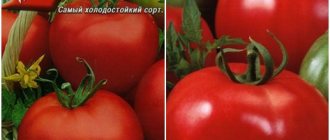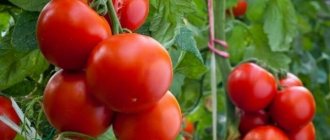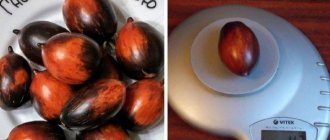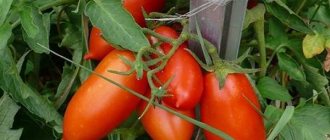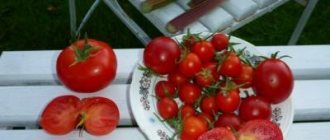Varietal tomato, originator - agro, registered in the State Register in 2004. Recommended for growing in open ground and in film shelters. Flash tomatoes are intended for commercial production, cultivation in private farms, the purpose of the variety is salad.
| Height | Landing location | Ripening time | Fruit color | Fruit size | Origin | Fruit shape |
| short | Open ground | Ultra early | Reds | Average | Variety | Round |
Description and characteristics of the variety
The outbreak belongs to the determinant group, the bushes are small, stocky, grow up to 40-50 cm. The tomato is ultra-early, 95-100 days pass from germination to the first fruits. The leaf blades are medium sized, dense, dark green in color. Plants are heavily leafy. The inflorescences are simple, the first appears above the 5-6th leaf, the subsequent ones are laid through the leaf or immediately after each other.
The lifespan of tomatoes is short. The plant is completed after 4-5 brushes; after harvesting, the bushes are removed from the garden bed.
The tomatoes are medium-sized, smooth, round, covered with thin red skin. The ribbing in the upper part of the fruit is weakly expressed. The pulp is 5-6 chambered, tender, with an average amount of seeds and liquid. The tomatoes are juicy, sweet, with a pleasant sourness.
How to grow
Despite its resistance to weather conditions, the Flash requires comprehensive care. The yield indicator directly depends on this.
Agricultural technology in general is simple:
- Seedlings begin to be prepared in late March - early April. The sowing date is determined taking into account the transplantation of seedlings to a permanent place no earlier than after 50 days. It is advisable to add to this period a week for germination and 5 days for the plants to adapt to the new location.
- Before sowing, planting material is soaked for 10 hours in a weak solution of potassium permanganate to disinfect it.
- Seedlings are provided with the necessary conditions for effective growth: systematic watering, loosening the soil, and applying fertilizers.
- Plants are accustomed to sunlight in advance and hardened. To do this, 10 days before transplanting into the ground, the bushes are taken outside and left for several hours.
- Planting in open ground occurs in early June. Planting pattern - 40x60 cm.
- To obtain an early harvest, in some cases the stepsons are removed. This will protect the crop from being overloaded with fruits and damaging the branches.
- They systematically water, weed and fertilize the tomatoes, and do not forget about loosening the soil. Fertilizers are applied once every 3 weeks.
Reference! Liquid organic compounds are the best fertilizers for crops. Suitable infusions include cow manure, chicken manure or grass clippings.
Some summer residents grow compact bushes of low-growing tomatoes Flash in special boxes. To do this, set up a rectangular wooden frame in a small area (6x1.2 m), into which fertile soil is poured.
This method of cultivation has several advantages:
- row spacing does not require maintenance;
- there are convenient passages between the beds;
- the ability to install arcs for covering material that protects plants from adverse weather conditions.
Advantages and disadvantages
Pros:
- Adapts to weather changes, tolerates mild cold snaps without shedding the ovary.
- The bushes are compact and suitable for growing in small areas.
- Low growing, require minimal attention.
- The fruits have an attractive presentation.
- The plant is resistant to fungal diseases and is rarely affected by pests.
- Ripe fruits are tender and tasty. Suitable for fresh consumption, salads, and preparations.
Minuses:
- Unsuitable for whole-fruit canning; the tomato skin is thin and the flesh is not dense enough.
- Compared to tall tomatoes, the yield is average.
Reviews from gardeners
Farmers speak positively about the crop, noting its unpretentiousness, early and long-term fruiting, stability and pleasant taste of the fruit. Here are reviews from those who have already planted this variety.
Yulia, Moscow: “ When growing Flash, the main thing is not to rush to plant seedlings: they grow quickly, outgrow and take root worse. This is generally an early ripening variety. It performed well in open ground. Of course, the yield cannot be compared with two-meter greenhouse plants, but there is practically no care. Low bushes, as in the photo, some even managed without a garter, there are no problems with stepchildren. I liked the tomatoes: medium in size, just right for pickling, but I didn’t get around to it: they were sweet, we ate them all just like that. Vegetables have thin skins, but I don’t like thick-skinned ones, I’m tired of store-bought ones. They began to bear fruit early, and it took a long time for new ones to appear. This year I will plant for sure.”
Svetlana, Voronezh: “I sowed the outbreak in February for an early harvest. The first fruits were harvested in July. Bushes grew in a greenhouse. I thought they would hand over the first harvest and I would free up the beds, but that was not the case. The outbreak bore fruit tirelessly until frost. In the summer it was finished, but it produced stepsons and continued to bear fruit on them. The tomatoes are early, medium-sized, not watery, but quite the opposite: sugary on the surface and sweetish. The height in the greenhouse was about 50 cm, the bushes were quite wide.”
Features of cultivation and storage
Tomato seedlings grow quickly, so a bush sown too early will stretch out, take root less well in the garden, and become more susceptible to disease. Tomatoes are grown in seedlings and without seedlings. The bushes do not need to be formed or pinched, but they do need to be tied up.
The more sunlight the plants receive, the sweeter and richer the taste of ripe tomatoes.
Tomatoes can be stored and transported in a state of technical ripeness. But ripe fruits are not stale. If the standards are observed, the shelf life without loss of commercial quality is no more than 2-3 weeks.
Features of care
Ultra-early ripening allows gardeners to obtain an early harvest, both for their own consumption and for sale on the market. To grow tomatoes in heated greenhouses, greenhouses, and even in open ground, you need to take care of high-quality seedlings.
Planting seeds
To grow seedlings, you need to prepare the container and soil. You can use ordinary wooden or plastic trays or special cassettes as containers. The main requirement is to carry out disinfection and ensure the drainage of excess moisture.
We purchase ready-made soil or prepare the soil mixture ourselves. To improve the quality of land taken from a summer cottage, you need to:
- add peat, humus to increase fertility (you can also use ammonium nitrate or ammophosphate);
- sand or sawdust, if the soil is “heavy”, clayey;
- ash, chalk or dolomite flour with high acidity.
We plant the seeds in the prepared mail not deeply - up to 5 millimeters. You can scatter them over the surface and cover them with a small layer of earth. Then the soil needs to be moistened with a spray bottle, covered with film and placed in a warm place (with a temperature of about 25 degrees) for germination.
Seedling care
After the first two leaves appear, the film is removed and the seedlings are transferred to a bright but cool place with a temperature of 15-18 degrees. For the full development of young plants, daylight hours must be at least 10 hours, so if necessary, additional lighting must be turned on. After 10 days of hardening, the temperature is increased to 20 degrees.
The seedlings are watered as needed, and organic and mineral fertilizers are applied. After two true leaves appear, diving can be done. Plants are planted one at a time in plastic cups or small pots. Experts recommend arranging the picked seedlings so that there is space between the rows of cups. This is necessary for the formation of shoots.
Landing in the ground
The bushes are planted in the ground at the age of 40-50 days. It is better to use the transshipment method - move the bush along with a lump of earth, so as not to injure the root system and reduce the time it takes for the plant to adapt. Before planting, complex fertilizers for tomatoes or rotted manure are applied to the soil. The planting rate is 4-6 plants per 1 square meter. Thickening of plantings should not be allowed, as this will lead to a decrease in yield.
The hybrid does not require pinning. According to vegetable growers, it is necessary to remove excess shoots if tomatoes are grown in northern regions with short summers, for timely ripening of the crop.
Watering and fertilizing
Water only at the roots
Pink Bush tomatoes do not require special care. It is necessary to follow simple watering rules:
- Apply water to the roots, avoiding contact with the leaves;
- the timing of watering depends on weather conditions (open ground) and is determined by the drying of the top layer of soil (greenhouses and hotbeds);
- after watering, the soil must be loosened, since tomatoes, especially young plants, need sufficient oxygen; loosening is one of the ways to prevent diseases;
- do not allow excess moisture, since the taste of the fruit deteriorates, tomatoes may crack, and favorable conditions are created for the spread of fungal diseases.
Plants are fertilized 3-4 times: a week after planting seedlings, during flowering, fruit set, and at the beginning of fruiting.
Tomatoes for the Moscow region
Summer residents of the Moscow region love to experiment and plant new varieties of tomatoes every year. Many people grow yellow varieties. Sugar content is increased by regular watering and potassium supplements. Potassium humate, potassium sulfate, and ash infusion are used.
Amana orange
Tomatoes of American selection are very popular among summer residents near Moscow. It is chosen for its original fruity taste, juiciness, and low seed content in the pulp. Grown in greenhouses. Bushes up to 2 m tall, they grow in 2-3 stems. Characteristics:
- ripening period is mid-early;
- regular, flat-round shape;
- weight – 400-800 g;
- universal purpose.
The Aman orange tomato has no disadvantages.
Yellow Queen
- ripening period (days) 95-105;
- weight – 700 g;
- shape – flat-round with slight ribbing;
- harvest from 1 m² - 10 kg.
Bella Antonovna, 51 years old, Klin
I really love the yellow queen. One of the first to bear fruit. I form the bush into 2 trunks. Productivity is good. I release my own seeds.
Galina Markovna, 43 years old, Shatura
I plant it in open ground. Bushes no higher than 1 m, powerful, wide. There are a lot of stepchildren being released. Due to lack of time, I removed them irregularly, so there were 5-6 trunks in 1 bush. But the harvest was good. The lower tomatoes are large, the upper ones are smaller. Very sweet. I plan to plant it next season.
Prevention of diseases and pests
Carrying out agrotechnical measures in compliance with all recommendations does not guarantee a high-quality harvest. When growing tomatoes, farmers face plant infestation or pest attacks.
The Vspashka variety is resistant to many diseases, including late blight. However, certain risks exist, so vegetable growers take preventive measures.
The main fungal diseases of the crop are late blight, black leg, white leaf spot, fusarium wilt, black, white and gray rot.
To prevent infection, the following measures are taken:
- spray the seedlings with copper oxychloride;
- remove non-viable leaves in a timely manner;
- a week before the intended planting, fertilizer “Trichodermin” is applied to the soil.
Other pathogens that cause diseases in tomatoes are viruses. To prevent such diseases, do the following:
- plant the crop in an area where tomatoes have not grown before;
- prevent the appearance of pests that carry viruses;
- clean the soil in a timely manner and remove weeds;
- carefully process all containers, tools and the greenhouse itself.
Another problem is the defeat of tomatoes by bacterial diseases (black bacterial, brown leaf spot, stolbur and bacterial mottling). To prevent infection, planting material is treated with insecticides, antibiotics are used, and the immunity of the shoots is increased.
Often, the yield of a crop decreases due to its damage by non-infectious diseases. They are caused by an imbalance in the mineral nutrition of the bushes. To avoid this, follow the rules and technology of planting, do not neglect fertilizers, but apply them in a balanced amount.
In addition to diseases, insects cause damage to the crop. The most dangerous pests for tomatoes are whiteflies, mole crickets, spider mites, wireworms, sprout flies, slugs, cutworms, aphids and Colorado potato beetles.
Insecticides are used to protect plants (Aktaru, Mospilan, Prestige, Fosbecid, Tsitkor). Traditional methods are also effective in the fight against insects - a solution based on laundry soap, an infusion of garlic or tobacco, herbal compounds, cat flea drops, a mixture of tobacco dust, hot pepper and ash.
New tomatoes and old problems
It's time to write about our tomatoes.
Since last year we were tormented with gartering tall determinate tomatoes, this year we decided to try to grow standard ones (up to 50 cm), and very slightly determinate ones - up to 1.5 m, using an individual garter for them.
On April 14, we sowed six varieties of tomatoes: Little Red Riding Hood, Flash, Penguin F1, Red Sugar Plum, Sugar Baby F1, and an unnamed salad-type variety, Sweet Unknown (well, very sweet), which our mother produces year after year.
Germination and subsequent care
April 27. Tomatoes “Flash”, “Penguin”, “Sugar Plum”, “Sweet Unknown”, “Little Red Riding Hood” 6 days.
On April 21, the long-awaited tomatoes of all varieties appeared, except for “Sugar Baby”. Therefore, on the same day, just in case, the remains of the seeds of the “baby” were sown in the second box - SedeK was no longer trusted... It turned out that the doubts were not in vain: in the first box it never sprouted, and in the second only 2 weak seeds sprouted, only 3 May.
Therefore, on May 3, I only picked tomatoes of the following varieties: “Little Red Riding Hood” (7 pieces), “Flash” (4 pieces), “Penguin F1” (3 pieces), “Red Sugar Plum” (4 pieces) and “Sweet Unknown” ( 5 pieces), leaving 2 empty spaces for “Sugar Baby”.
May 3. We pick the tomatoes into a marked large box (45x45 cm), choosing the strongest plants.
May 3. Pickled tomatoes...
When picking determinate tomatoes, the sprouts were buried to the cotyledons, and the standard ones were transplanted without deepening, since T. Ugarova does not recommend deepening standard tomatoes.
16th of May. Tomatoes live on the balcony...
May 19. There are now 25 tomatoes in the box! Little Bushes - Sugar Baby. The older tomatoes are almost a month old.
Planting tomato seedlings on a narrow ridge
June 13. The tomatoes were planted on bed No. 4. They were immediately fed with urea for better rooting.
On June 13, we decided to plant our tomatoes in open ground. The age of the older tomatoes at the time of planting was 53 days, the Sugar Baby was 41 days.
25 bushes were placed on a 4.5-meter ridge in a checkerboard pattern in two rows with a distance between bushes of 35 cm. Planted from north to south: Sugar plum (4), Sweet unknown (5), Flash (4), Penguin (3), Little Red Riding Hood (7), Sugar Baby (2).
Determinate varieties were planted from the north so that they would not cast a shadow on the shorter standard varieties.
The tomatoes were immediately fed with urea (30 g/m) for better rooting of freshly planted seedlings.
Feeding tomatoes. Phosphorus deficiency
From the third day after planting, seedlings begin to be fed with mixture No. 2.
On June 16, the tomatoes received their first fertilizing with mixture No. 2 (superphosphate, Mittlider version).
June 16. The first feeding of tomatoes with mixture No. 2, 25 grams per linear meter.
June 18. The tomatoes recovered and raised their leaves...
June 20. Tomatoes showed the first signs of phosphorus deficiency...
On June 20, the first signs of phosphorus deficiency were found on tomato leaves: small leaves, stunted growth, unfolding of leaves and their purple color.
A decision was made to correct phosphorus deficiency, but was never implemented. Instead, on June 23, a second feeding was carried out with mixture No. 2 of a different recipe - based on ammophos, and we increased the dose to 36 grams (for ordinary soils).
The decision to increase the dose of fertilizer mixture was not made spontaneously.
More than once we have noticed signs of starvation of our crops: last year, cabbages did not have enough 5 fertilizing - in the last month of the growing season they showed phosphorus deficiency, cucumbers experienced potassium starvation throughout the entire growing season, boron deficiency and a lack of molybdenum were observed everywhere.
The next day the tomatoes were better! The purple color of the leaves has faded. And the leaves themselves began to unfold, turning the upper side of the leaf blade towards the sun. The tomatoes began to grow and the buds opened.
It is quite possible that this is only a temporary relief - the resulting easily digestible phosphorus in the form of ammophos will be quickly used up, and we will still have to make adjustments. But the positive response from the plants itself gives us hope.
June 24. A bed of tomatoes 10 days after planting. We recovered and began to grow.
June 24. The first tomatoes have appeared! The photo shows the standard variety Red Riding Hood.
Today small fruits were found on the Sweet Unknown and Little Red Riding Hood tomatoes. I think if you look hard enough, you can find ovaries on bushes of other varieties.
See you!



